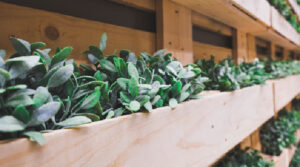Vertical gardens are a huge trend right now, and for a good reason: They allow urban gardeners to save enormous amounts of space, increasing yields and transforming boring old walls into living pieces of art.
These living walls have been hailed as the next big thing for sustainable cities, as they improve the quality of the air, reduce the urban heat, increase the energy efficiency of homes, and reduce noise pollution.
In this article, we’ll show you how to build your own stunning vertical garden using upcycled wooden pallets that you can get for free or very cheaply.
The degree of complexity is up to you. You can paint them any color you want, restore the wood, and affix them high up on a wall. On the other hand, you can simply take a pallet, fill it with pots and lean it against your balcony wall. In the guide below, we’ll guide you through all the possible alternatives.
How to Transform an Old Pallet into a Vertical Garden
Step 1- Find used wooden pallets
If you read the article title and thought this guide would only be relevant to people with old wooden pallets laying around, think again.
Finding them for cheap is half the fun, and if you follow our advice you might even be able to grab some for free!
The first and most obvious place to look is on Craigslist. Oftentimes, small businesses will give away pallets that aren’t in great condition or that they no longer need.
If you can’t find any this way, head over to the closest industrial area and ask around for used pallets. A lot of businesses, such as your local newspaper, hardware stores, lumberjacks, and construction companies, will have pallets laying around that they no longer need. Ask them nicely, and they might just give you one.
Step 2- Restoration (optional)
There’s a good chance that you’ll find a pallet in less than a decent condition. Even if you get one brand new, you’ll probably want to use it outdoors on a balcony or against a garden wall. For that reason, treating the wood and applying a topcoat is a good, but not a mandatory, idea.
Restoring the wood can be as complex or as easy as you wish. You can go the full nine yards and sand the wood, stain it with the desired color, and then apply a topcoat such as polyurethane, or you can simply apply the coat.
This decision will depend on the condition of the wood. But in most cases, we recommend simply applying the coating. Polyurethane is our recommended coating as it is durable and comparatively affordable.
Step 3- Final Woodwork
Your pallet is now ready for the outdoors. But before you install it, you need to make some adjustments to the structure to support the vases and affix them to the wall.
The first thing you’ll want to do is nail down a board in each division of the palette. This will form a ledger where the vases will sit. Applying the dirt directly to the ledger is not advisable. This is because it does not offer the proper drainage needed for the plants to thrive. It can also lead to wood rot, even if properly coated.
If you’ve got any experience with DIY, this should be fairly straightforward. No power tools should be needed. Simply cut a piece of wood with a saw to the required dimensions. Then coat it with Polyurethane, and nail them with a hammer.
You may also want to remove some of the divisions to allow for more space to grow per ledger. However, if the wood isn’t in a great state, the best thing to do is not tinker with it much.
The American pallet is 144mm wide, meaning that you’ll want to find long vases with less than this diameter.
Finally, to fix the structure, you’ll want to
- drill holes into the wall
- stick an anchor in it
- drill a hole in the pallet with the same distance as the wall holes.
You can then hang the pallet with a nail that’s at least 3 inches long.
 And voila–you have a stunning vertical garden!
And voila–you have a stunning vertical garden!
And there you have it: Your own vertical garden almost for free, the final project should look something like this: Some great plants to grow in this kind of structure are strawberries, rosemary, and any kind of vine. Enjoy this beauty in your yard or donate it to your local community gardening project.



